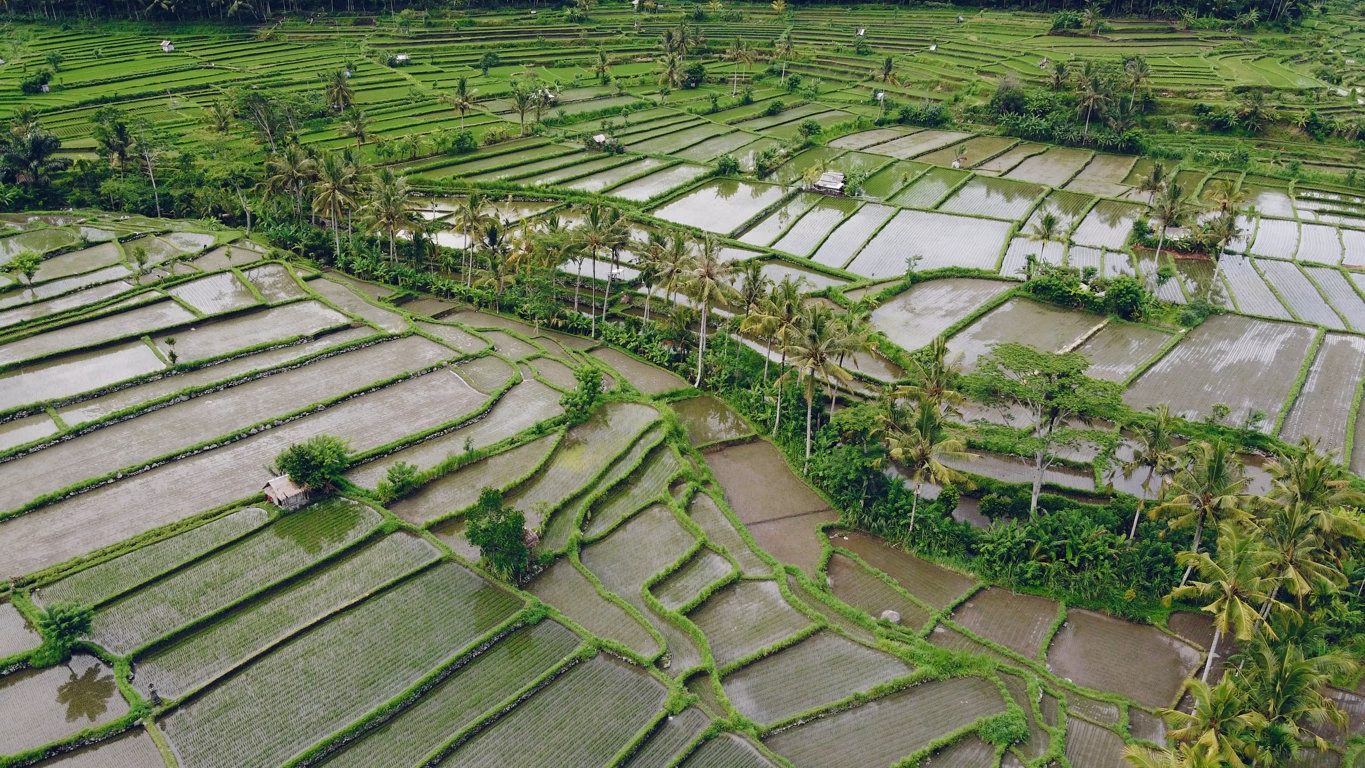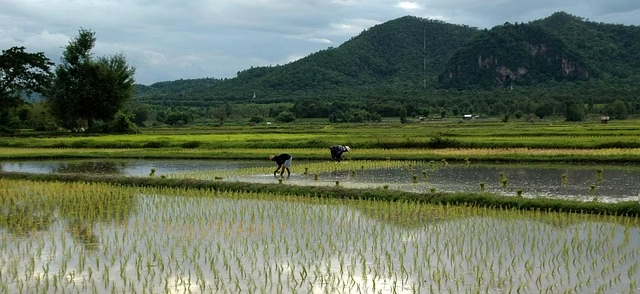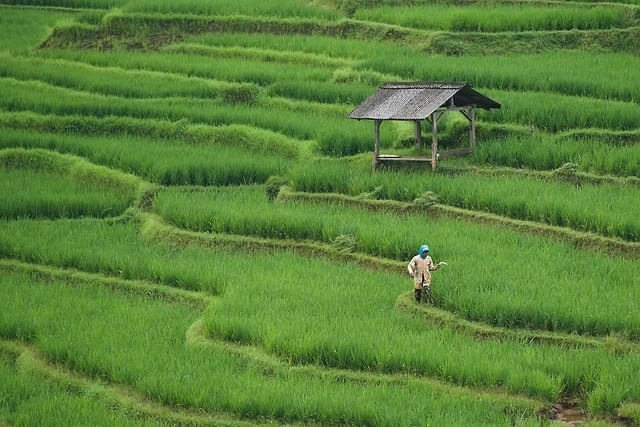
The Basin Irrigation System is one of the oldest irrigation systems used in this modern era of agriculture.
Even to this day, it is the common surface irrigation system used all over the world to grow crops needing standing water.
This traditional surface irrigation technique has sustained agricultural communities for thousands of years and continues to play a crucial role in modern farming practices worldwide.
What Is Basin Irrigation System
Basin irrigation system is the system where water is applied to the enclosed or leveled areas surrounded by earth ridges or bunds.
Water flow is controlled within these boundaries to infiltrate the soil, creating a temporary shallow lake or flooded area over the crop root zone, allowing water to soak deeply into the soil profile.
This irrigation system is suitable for crops that are unaffected by standing water for long periods, like paddy and rice.
The basin irrigation system works on the principle of gravity flow, where water moves from higher to lower elevations and spreads uniformly across the field.
Types of Basin Irrigation System
Check Basin Irrigation Method

In this method, land is divided into small basins interconnected to each other.
Water flows from one basin to another through small openings in the separating bunds, allowing for better water control and management.
This method is particularly suitable for sloping terrain and provides flexibility in irrigation scheduling.
In my locality, where the basin system is used to grow rice, check basins are a common method, especially at the side or starting line of the rice-growing area where water is enough.
Flat Basin Method

Here, the land is large, enclosed by the bunds, and flooded simultaneously.
This method of basin is fit for crops like rice that require continuous flooding.
The entire basin is flooded at once, creating uniform water depth across the field. This method is ideal for flat or gently sloping lands.
In my locality, check basins serve the water to the flat basins.
Contour Basin Method

In this basin method, land is divided into smaller levels of basins (or paddies) that follow the natural contour lines of the land.
Following the natural contours of sloping land creates a series of terraced basins at different elevations.
This method prevents soil erosion on slopes while ensuring effective water distribution. Each basin captures and retains water at its level, preventing runoff and maximizing infiltration.
Advantages of Basin Irrigation System
Water Efficiency
When properly designed and managed, the basin can achieve 60% to 80% water efficiency.
The enclosed nature of basins prevents surface runoff, ensuring that most applied water infiltrates into the soil and becomes available to plants.
Deep Water Penetration
Because the water stays long-term on the land, it allows for deep soil water penetration, which is beneficial for deep-rooted crops and helps establish extensive root systems.
This deep water storage can sustain crops during dry periods between irrigations.
Low Energy Requirement
The whole basin irrigation is operated on gravity flow, eliminating the need for pumps or pressurized systems.
This results in minimal energy costs and makes the system accessible to farmers with limited resources or unreliable electricity supply.
Simple Construction and Maintenance
The basin irrigation system does not need any special skills or heavy labor and tools to manage.
Maintenance involves periodic repair of bunds and clearing of distribution channels, which farmers can easily manage.
Weed Control Benefits
The flooding nature of basin irrigation can help suppress certain weeds and pests that cannot survive in waterlogged conditions, reducing the need for herbicides and pesticides.
Effective Salinity Management
Basin irrigation can help manage soil salinity through leaching excess salts below the root zone.
The deep water infiltration characteristic of this method facilitates salt removal and prevents salt accumulation in the crop root zone.
Disadvantages and Limitations
High Water Requirements
As you know, the water is filled in the basin to penetrate the soil deeply, making it a less suitable irrigation method in hot and drought-prone regions.
Labor Intensive
Basin irrigation doesn’t need much labor to manage, but it requires intensive work for activities such as bund construction, maintenance, water distribution, and field preparation.
Limited Crop Suitability
Not all crops are suitable for this irrigation. Only crops that are tolerant to the flooding conditions and benefit from it are suitable.
Many horticultural crops and vegetables cannot withstand prolonged waterlogging, limiting the versatility of this irrigation method.
Potential for Waterlogging
If there is no proper drainage, overwatering can lead to waterlogging.
Poor drainage can also create anaerobic soil conditions harmful to plant root development.
Soil Erosion Risk
Again, if not properly managed, basin irrigation can cause soil erosion, particularly during the initial flooding phase when water velocity is high.
Suitable Crops for Basin Irrigation
Rice
Rice is the most common crop grown in the basin irrigation because of the it’s ability to thrive in flooded conditions.
Apart from that, it is also easy to control the weeds and provides the anaerobic conditions that rice plants prefer for optimal growth.
Wheat
Another popular choice for the basin system is wheat crop. Not all regions support the basin system to grow wheat, only regions with clay soils that benefit from deep water infiltration.
The method provides adequate moisture for wheat’s growth cycle while being cost-effective for large-scale production.
Cotton
Due to cotton’s deep root system and high water requirements, the basin irrigation system is employed.
The method ensures adequate moisture throughout the growing season while being economically viable for commercial cotton production.
Sugarcane
Sugarcane’s high water demand and ability to tolerate waterlogged conditions make it well-suited for basin irrigation.
The method provides the consistent moisture needed for optimal sugar content development.
Fodder Crop
You can even grow various fodder crops, including alfalfa, berseem, and other leguminous crops.
The deep water penetration encourages extensive root development and higher biomass production.
Key Components of Basin Irrigation System
Water Source and Water Supply
Basin irrigation needs adequate water supply sources like rivers, canals, wells, or reservoirs that provide adequate water supply throughout the irrigation season.
Basin Construction and Layout
A basin is made out of earth embankments called bunds or ridges. To successfully hold the water, these barriers are typically 15–30 centimeters high.
The size of basins varies depending on land topography, soil type, crop requirements, and available water supply, ranging from small plots of 0.1 hectares to larger areas exceeding 1 hectare.
Inlet and Outlet Structures
Controlled inlet structures regulate water flow into basins, while outlet structures allow drainage when necessary.
These may include simple openings in bunds, gates, or more sophisticated control structures that enable precise water management.
Land Leveling and Grading
For optimum usage of the basin system, land must be prepared and leveled so that there is no waterlogging in low areas.
Precise grading helps achieve optimal water depth across the entire basin area.
Final Thoughts…
Basin irrigation methods play an important role in global agriculture, providing a cost-effective and reliable method for crop water management. Most rice is produced using the basin irrigation method.
This irrigation system is fit for various agricultural situations like flood-prone areas and places with adequate water supply.
The success of basin irrigation depends on proper design, construction, and management practices tailored to local conditions.
As global water resources become increasingly scarce and valuable, the future of basin irrigation will likely involve continued optimization to balance productivity, economic viability, and environmental sustainability.

Leave a Reply